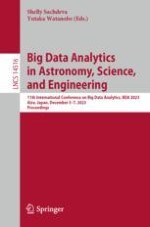2024 | Buch
Big Data Analytics in Astronomy, Science, and Engineering
11th International Conference on Big Data Analytics, BDA 2023, Aizu, Japan, December 5–7, 2023, Proceedings
herausgegeben von: Shelly Sachdeva, Yutaka Watanobe
Verlag: Springer Nature Switzerland
Buchreihe : Lecture Notes in Computer Science
